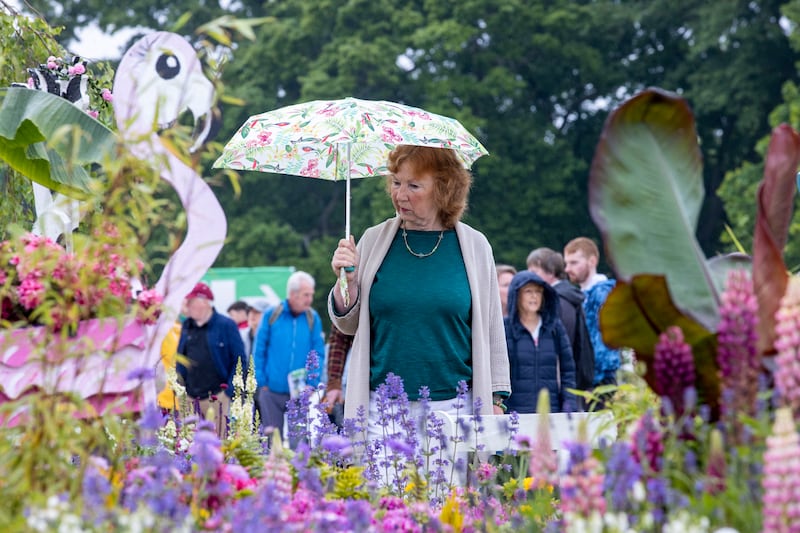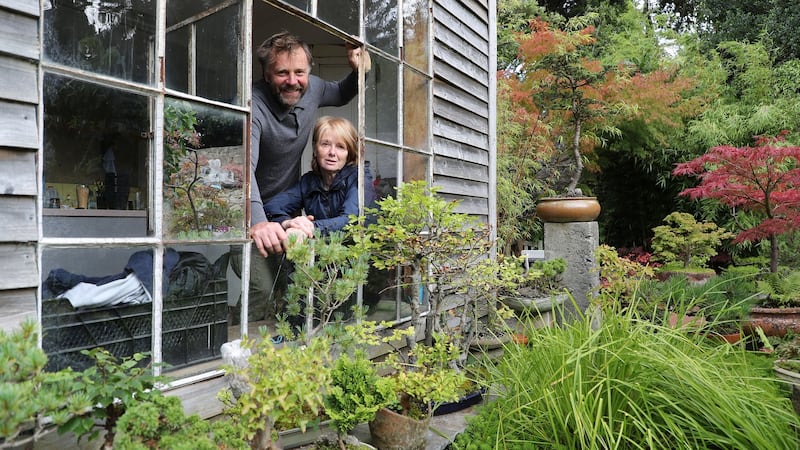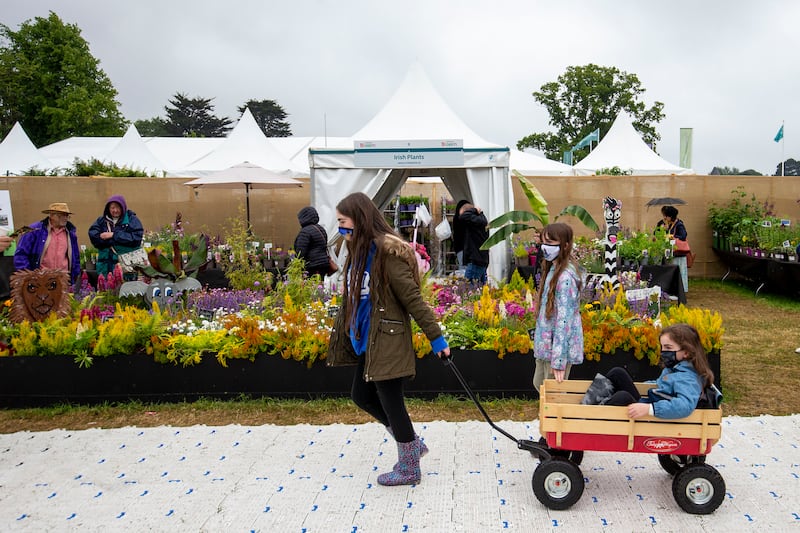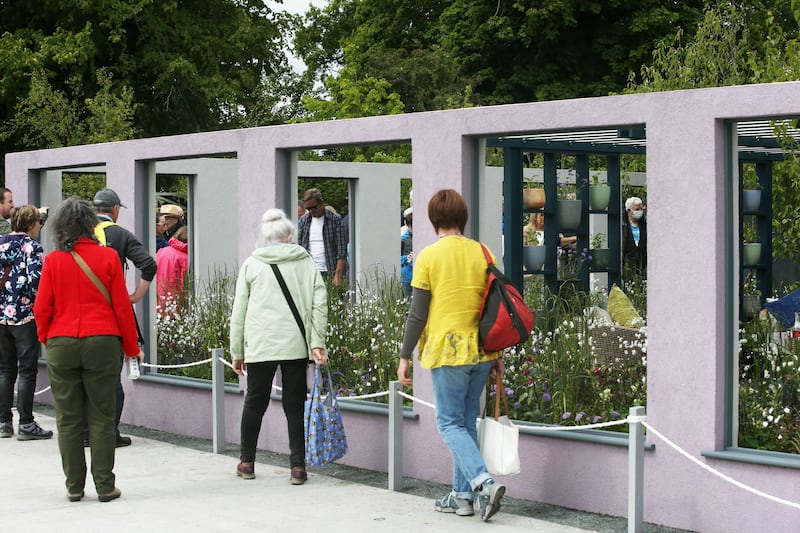Bloom is the biggest annual event in the Irish gardening calendar featuring show gardens of all sizes, themed floral displays, nursery displays, plant sales and a range of interactive platforms where visitors can get professional advice from a host of gardening experts. Before you go here’s what you need to know, along with some of the highlights of this year’s show.
When is it on?
Bloom 2023 takes place this bank holiday weekend from Thursday, June 1st, until Monday, June 5th. The festival runs from 9am to 6pm each day.
Where is it on?
The festival is in the Phoenix Park Visitor Centre, Dublin. The centre is located on the main Chesterfield Avenue road which runs from the park’s main gate at Parkgate Street to the Castleknock gate.
Where can I buy tickets?
Tickets for Bloom, which are valid for one day only, can be purchased through the Ticketmaster website. Adult tickets are €30 and concession tickets, for students and senior citizens (aged 66 and over), are €25. Admission is free for up to two under-16s per paying adult. Tickets for additional children are €4.50 each.
READ MORE
Some tickets will be available at the gate, however the event organisers say they cannot guarantee that tickets will be available on popular days. Booking online in advance is recommended to avoid disappointment.
How do I get there?
By foot: Bloom is easily accessible by foot – it is about a 30-minute walk from the gate at Parkgate Street to the front entrance of the festival. From the Ashtown or Cabra park gates, it is a five-minute walk to the back entrance of the festival.
By bike: Attendees can cycle right up to the Bloom entrances and park and lock their bikes in the available cycle parks.
By train/Luas: If you are travelling by train or Luas, the closest station to the festival is Heuston. You can then hop on the free shuttle service operating from Parkgate Street to Bloom and back. The shuttle will be operating from 8.30am to 7pm each day. Organisers are advising visitors to leave 90 minutes from departing Bloom to your train departure time.
By bus: There are several public bus routes that can be taken. Routes 7, 38, 38A, 38B, 38D, 39, 39A, 70, 70D and 122 stop on the Navan Road which is a 15-minute walk to the back entrance of Bloom. The 46a stops at the North Circular Road entrance which is a 30-minute walk to the show.
By car: If you are travelling by car from the city centre, you can use the Parkgate Street, Cabra or NCR entrances to the park. Traffic from north of the city or the M50 can enter the park using the Castleknock, Ashtown, Knockmaroon and Chapelizod gates.
Tickets for parking cost €5 for the day and can be purchased in advance on the Ticketmaster website.
Where can I grab something to eat?
Fear not, you will be spoiled for options when it comes to food at Bloom. From picnic areas to food stalls, and the Bistro Bloom, there is something for everyone.
Attendees hoping to dine in the Garden View Restaraunt, which overlooks the show gardens, should book in advance on the Bloom website.
Attendees can also relax at the Bloom Inn where there will be cooking demonstrations and opportunities to “sip something special from Ireland’s best brewers and distillers”.
Anything else?
If you’re buying plants, you can put them aside until you’re ready to leave by using one of the two free plant creches. There will also be a “wheelbarrow taxi service” to help people get their purchased plants back to their car if they are parked in either the Red or Green car park.
If you need any more information before you head to the festival, check out the Bloom website here. Meanwhile, take a look below for details of some highlights you don’t want to miss.

21 show gardens to see:
Bloom’s show gardens have always been at the heart of the event, a great coming-together of established talent and up-and-coming designers eager to make their mark in the industry. This year’s show introduces one of the youngest-ever participants, 21-year-old Joe Eustace from Newbridge in Co Kildare, who will be creating a small show garden for the event.
Eustace is studying for a degree in landscape architecture at University College Dublin. He is the winner of organiser Bord Bia’s brand new Cultivating Talent initiative, which provides financial and practical support to first-time Bloom show garden designers. He is mentored by the experienced landscape designer and former Bloom Gold Medal winner Nicola Haines, of Dublin-based Tierney Haines Architects (who’s also exhibiting at this year’s show). Eustace may be a newcomer to Bloom, but he’s no novice when it comes to the industry, having already proved his mettle by establishing the pandemic start-up business Online Garden Designs with his landscape designer father Ken Eustace. The Next Step, his first ever Bloom show garden, features a pool surrounded by lush planting and overlooked by a scarlet steel plunge board that invites viewers to contemplate life’s twists and turns and the challenges we must face with fortitude to continue our own personal growth and development.

More familiar names returning to the event include Dublin-based designers Liat and Oliver Schurmann of Mount Venus Nursery, who have created some of Bloom’s most memorable gardens ever since the show began back in 2007. Called ‘The First 5 Garden of Wonder and Discovery’, their large show garden design is sponsored by the Department of Children, Equality, Disability, Integration and Youth as part of the government’s First 5 strategy to support children and their families in the early years of life. Featuring a woodland space intersected by twisting paths, a willow tunnel, miniature waterfalls and a stream, it celebrates the joy and inspiration to be found in a natural playground where children are free to roam and explore.
The formative role that a garden space can play in young children’s lives is also the theme of Belfast-based designer Linda McKeown, who has won many awards for her previous show gardens at Bloom and works as a horticultural therapist. Her garden, Raising Amazing, sponsored by Tusla Fostering, highlights the many ways in which access to nature can help nurture creativity, self-esteem and confidence in young children while simultaneously offering a place of safety and tranquillity.

Urban living and the need for an inventive, nature-friendly approach to creating green spaces in our towns and cities has been a repeating theme of Bloom show gardens over the years. This year’s show is no exception, with a range of gardens tackling the subject, including the seasoned Bloom designer and Dublin-based landscape architect Jane McCorkell, whose large urban woodland-themed design, A Breathing Space for Fingal, celebrates the joys of forest bathing with a firm focus on wellbeing and sustainability.
Almost all of the elements used in its construction are upcycled materials hand-chosen by McCorkell from Fingal County Council’s depot, home to myriad building materials that the council has put into safe storage over the years. They include rusty cartwheel rims artfully repurposed as an ornamental vertical garden screen, old kerbstones and ornamental rocks. Her design also features a green or “living” wall filled with Irish-grown plants, including many species of ferns, ajuga, brunnera and lamium and another made from recycled bottles. Continuing that theme of sustainability, the garden will be relocated to a new public space in Fingal after the show ends to serve as a commemoration to all those who suffered during the pandemic.
Green Cities Europe Parklet – designed by Daibhí MacDomhnaill of Áit Urbanism + Landscape, working in collaboration with Deirdre Prince, Gary Graham and Barry Lupton – imagines a world where innovative, creative urban planning brings nature to our doors, connecting us to the living landscape, which we rely upon for clean air and water as well as to help counter the challenges of climate change.

Meanwhile, Nicola Haines’s medium show garden, Citroën Power of One, explores how, with clever design, our front gardens can be little slices of nature that support biodiversity and help to tackle the problems of urban flash flooding and pollution rather than sterile paved parking spaces that contribute to them. Featuring a “living roof” planted with pollinator-friendly species of sedums, a rainwater-harvesting system, plenty of pollution-tolerant, resilient planting and a hard-surfaced area made from repurposed materials with high-embodied carbon such as concrete, brick, glass and steel (these were collected from building sites), it points the way forward in sustainable garden design.
With her Forest Balcony show garden, designer Kathryn Feeley explores the ways in which a joined-up urban planning and design process could allow the tiny city balconies of high-rise apartment blocks to be transformed into a series of small, interlinked leafy spaces, creating an “engineered forest” that mimics the different planting layers of a natural woodland from the upper storey of trees, shrubs and climbers to the understorey of perennials.

The joys and practical challenges of balcony gardening are also addressed by David Gallagher in his small show garden, Urban Roots Balcony, which highlights the need for resilient planting and clever ways to put all that vertical growing space to good use.
Bloom’s Postcard Gardens are always popular with visitors, showcasing the skills and interest of a wide variety of community-based groups and organisations around the country. This year’s line-up includes nine displays, from a mobile mini-garden on wheels designed for nursing homes by the students of St Kevin’s Community College in Clondalkin to a “sound garden” called Plants in Concert created by Klinkerdin Arts Salon in collaboration with the community garden Edible Bray. If you’re one of those gardeners who likes to talk to your plants, then you’ll be fascinated by the technology it showcases, which allows visitors to listen to plants’ different responses to their environment through a webcast.
Floral displays
Elsewhere at this year’s show, taking pride of place in the showground’s nursery village, you will find a host of floral exhibits by AOIFA (Association of Irish Floral Artists), displaying the skill and artistry of many of the country’s most passionate flower-fettlers. This year’s event is inspired by the theme of high-rise living and features a large-scale exhibit by members of the Wexford Garden & Flower Club using succulents and home-grown foliage along with seasonal Irish-grown flowers sourced from members of FFOIA (Flower Farmers of Ireland Association).
Gardening advice
For anyone in need of a horticultural agony aunt or just some down-to-earth, dirt-under-the-fingernails practical advice, head to Bloom’s garden and sustainability stages, where a variety of experts will be on hand, including reformed garden designer, author and founder of We Are the Ark movement Mary Reynolds. Other experts include Gerry Daly, horticulturist, broadcaster and consulting editor of The Irish Garden; holistic gardener and garden writer Fiann Ó Nualláin; Mary Keenan, the new editor of The Irish Garden and co-owner of Gash Gardens; plantsperson, author and owner of Hunting Brook gardens Jimi Blake; gardener and broadcaster Marie Staunton; Damien Regan of the Irish Seed Savers Association; Sarah Kelly of Biodiversity Ireland; Niall Hatch of Birdwatch Ireland; kitchen garden experts from GIY; plant scientist Dr Eoin Lettice; indoor plant expert Pat Keville of plantstore.ie; and young gardener, broadcaster and Youtuber Niall McCauley. You will also find plenty of practical advice on planting in the seven Dream Garden designs created by professional garden designers commissioned by Bord Bia and available to download from its website, which tackle everything from dealing with shade to designing for low maintenance.
Plants, plants, plants
For those in need of a plant fix, head to the show’s Q-Mark village, where you will find a selection of displays by some of the country’s small specialist nurseries. Exhibitors at this year’s show include Kells Bay House & Gardens; Shady Plants; Hopeless Botanics; Kilmurry Nursery; Riverlane Nursery and the Irish Fuchsia Nursery.
More inspiration
Whatever you do, make sure to also pay a visit to Ashtown Walled garden, a leafy, flower-filled oasis right in the centre of the bustling show grounds. Its double herbaceous border, vegetable beds and fruit trees, expertly managed by OPW, are always a joy to behold.
For tickets, detailed travel advice and a full list of exhibitors and events taking place at the show, see bordbiabloom.com














